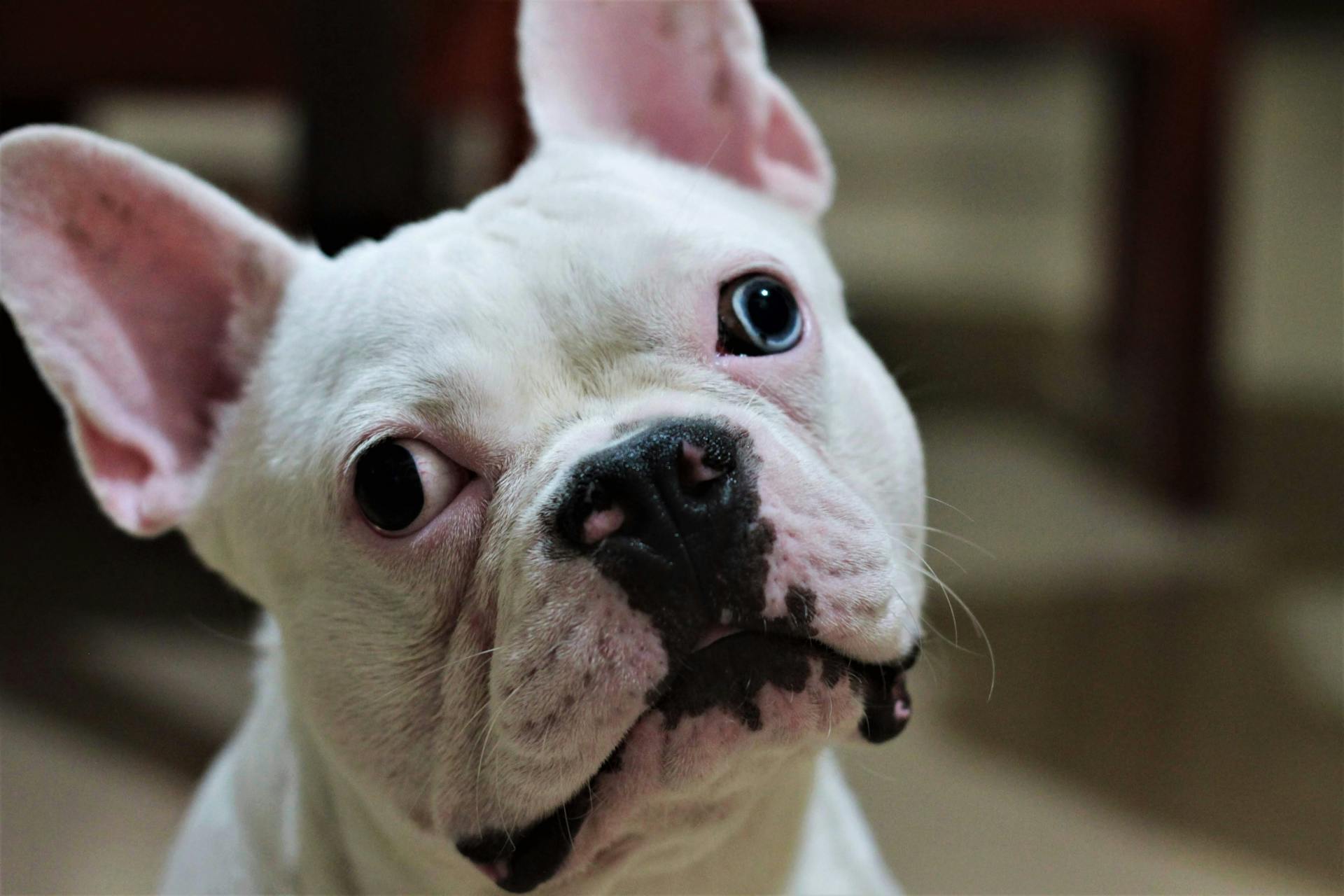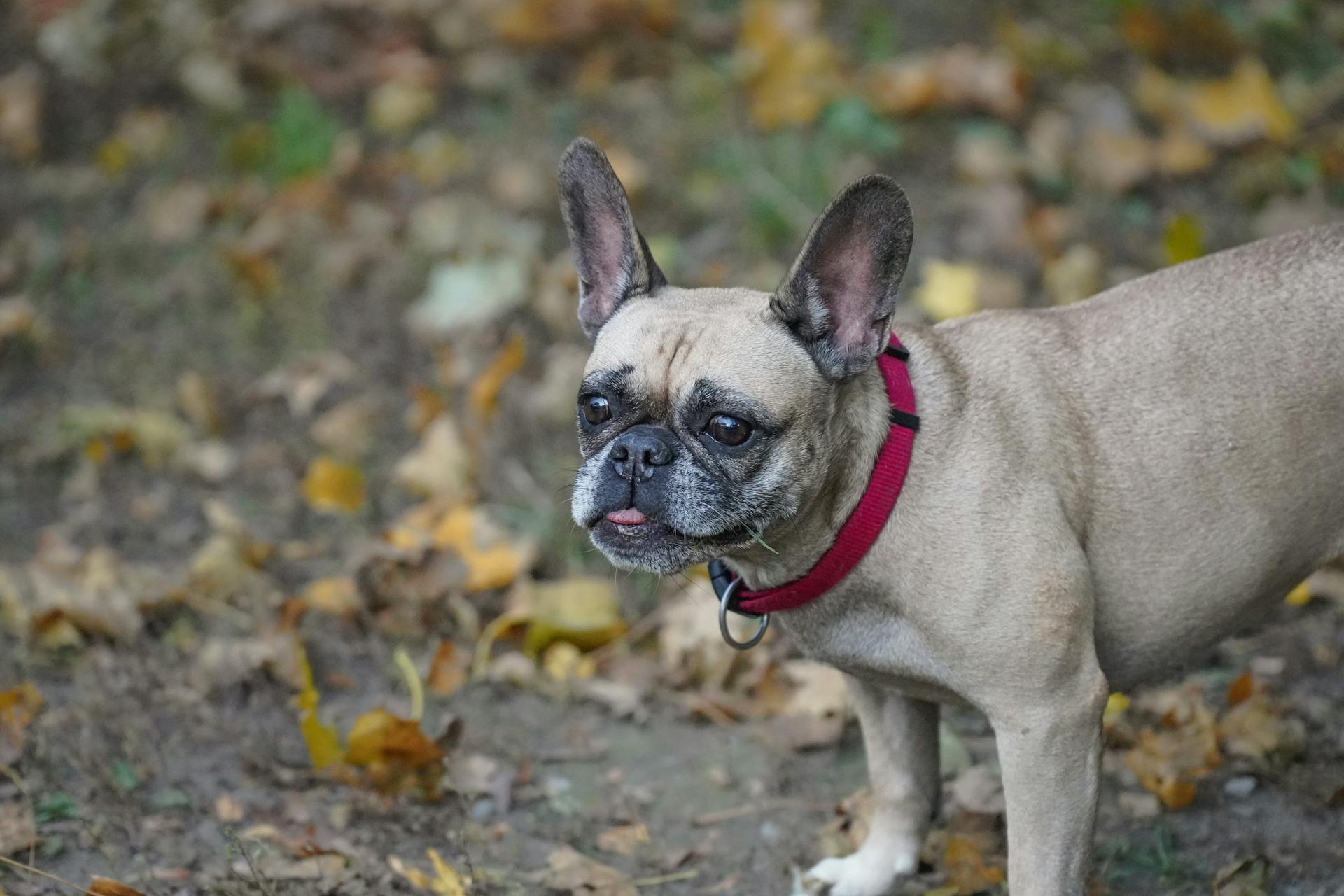
Hip dysplasia is a common condition in French Bulldogs, affecting up to 20% of the breed.
French Bulldogs are prone to hip dysplasia due to their brachycephalic skull structure and shallow hip joint.
The condition can cause arthritis, pain, and mobility issues in affected dogs.
It's essential to understand the diagnosis and treatment options for hip dysplasia in French Bulldogs to ensure they receive proper care and management.
Anatomy and Causes
Hip dysplasia in French Bulldogs is a complex condition that affects the anatomy of their hip joint. The hip joint is designed to allow a wide range of motion, with the femoral head fitting snugly into the acetabulum.
The femoral head and acetabulum are supposed to be congruent, or fitting together perfectly, in a healthy hip joint. However, in French Bulldogs, this congruence can be disrupted, leading to hip laxity, subluxation, and dysplasia.
Hip laxity refers to looseness or instability in the hip joint, where the femoral head and acetabulum don't fit together as snugly as they should. Subluxation is a partial dislocation of the hip joint, where the femoral head is partially out of the acetabulum but not completely dislocated.
Anatomy in Bulldogs

In bulldogs, the hip joint is a ball and socket structure that allows for a wide range of motion. The femoral head fits snugly into the acetabulum, a concave portion of the pelvis.
The hip joint's congruence is crucial for smooth and stable movement. However, when this congruence is disrupted, bulldogs may experience hip laxity, subluxation, and dysplasia.
Hip laxity refers to looseness or instability in the hip joint, where the femoral head and acetabulum don't fit as snugly as they should. This can lead to partial dislocation of the hip joint, known as subluxation.
A complete dislocation of the ball from the socket is called hip luxation. This can cause significant pain and mobility issues for bulldogs.
Here are some common hip dysplasia symptoms in bulldogs:
- Stiffness
- Climb & Jamp: Difficulty climbing stairs and jumping
- Pain: Crepitus and pain when the hip is extended or abducted
- Muscle Atrophy: Disuse atrophy (Muscle mass loss) of the dysplastic leg
- “Speedo Swimming Suit” (skinny hips, puffed shoulders) due to compensation and weight shifting to the front (shoulders, torso).
- Range of Motion: Decreased range of motion of the hip joint.
- Limp: Lameness or unloading of the dysplastic leg during exercise.
Hip structural abnormalities in bulldogs can include a shallow hip socket, short femoral neck, abnormal femoral head, and abnormal soft tissue and ligament attachments.
What Causes?
Hip dysplasia is a common condition that affects many dog breeds. Genetics play a major role in determining whether a dog will develop hip dysplasia.

Large breed dogs, such as Great Danes and German Shepherds, are more susceptible to hip dysplasia. Some smaller breeds, like Pugs and Boxers, are also prone to the condition.
In addition to genetics, other factors can contribute to hip dysplasia. These include improper nutrition, not enough exercise, and weight issues or obesity.
Selective breeding has made some breeds, like the French Bulldog, more likely to develop hip dysplasia. A list of breeds commonly affected by hip dysplasia includes:
- Great Dane
- Labrador Retriever
- Golden Retriever
- Bernard
- German Shepherd
- Rottweiler
- Newfoundland
- French Bulldog
- Chesapeake Bay Retriever
- Pug
- Boxer
Symptoms and Diagnosis
Hip dysplasia in French Bulldogs can be a real challenge for these adorable dogs. Frenchies are prone to this condition, which occurs when the ball doesn't fit the socket snugly in the hip joint.
The symptoms of hip dysplasia in French Bulldogs can be pretty easy to spot, especially in seniors. One of the most common symptoms is lameness in the hind legs.
Lameness is often accompanied by a loss of thigh muscle mass. You may also notice your Frenchie bunny hopping while walking, which is a clear indication of hip dysplasia. Decreased activity and an inability to jump and climb stairs are also common symptoms.
Here are some common symptoms of hip dysplasia in French Bulldogs:
- Lameness in the hind legs
- Loss of thigh muscle mass
- Bunny hopping
- Decreased activity
- Inability to jump and climb stairs
If you notice any of these symptoms in your Frenchie, it's essential to take them to the vet as soon as possible. Early detection and treatment can make a huge difference in your dog's quality of life.
Hip dysplasia can be painful for your Frenchie, and it's crucial to catch it early to prevent further damage. Your vet will perform an X-ray examination to confirm the diagnosis and determine the best course of treatment.
Remember, prevention is key when it comes to hip dysplasia in French Bulldogs. Regular exercise, a balanced diet, and a healthy weight can all help prevent or slow down the progression of this condition.
For your interest: English Bulldog Hip Dysplasia Treatment
Prevention and Treatment
Prevention is key when it comes to hip dysplasia in French Bulldogs. Regular exercise is essential, but avoid over-exercising as a puppy, keeping it gentle and low impact.
Feeding a high-quality diet and maintaining a healthy weight is crucial. Obesity can lead to muscle weakness and loss of cartilage, exacerbating the condition. A well-balanced diet rich in proteins and low in carbohydrates is essential.

Here are some key prevention and treatment measures to consider:
- Genetic factors, supplements and nutrition, and lifestyle factors all play a role in preventing hip dysplasia.
- Regular checkups at the vet, regular exercise, and a healthy diet can significantly reduce the risk and severity of hip dysplasia.
- Supplements such as vitamin C and E can also be beneficial, but always consult with a veterinarian before starting any supplement regimen.
- Non-surgical treatment options include physical therapy, weight control, and diet, as well as physiotherapy and swimming to build muscles around the affected area.
- Early diagnosis and treatment are essential to reduce the amount of damage and arthritis caused by hip dysplasia.
Preventing
Preventing hip dysplasia in bulldogs and French bulldogs involves a combination of genetic, nutritional, and lifestyle factors. By taking proactive steps, you can significantly reduce the risk and severity of this condition.
Genetic factors play a role, but you can't guarantee a bulldog will never develop hip dysplasia. Supplements and nutritional factors can help, but it's essential to consult with your veterinarian before starting any supplement regimens.
Regular exercise is crucial, but avoid over-exercising as a puppy. Gentle and low-impact exercise is best, and refraining from jumping and landing on hind legs can also help prevent hip dysplasia.
A high-quality diet and maintaining a healthy weight are also essential. Feeding your bulldog a diet rich in proteins and low in carbohydrates can help prevent obesity, which can lead to hip and joint stress.
Here are some key lifestyle factors to consider:
By following these tips and consulting with your veterinarian, you can help prevent hip dysplasia in your bulldog or French bulldog.
Bulldog Summary:
Hip dysplasia is a degenerative condition that causes irreversible damage to the hip joints, so it's essential to take preventative measures.
Regular exercise is crucial, but avoid over-exercising as a puppy, keeping it gentle and low impact instead.
Feeding a high-quality diet and maintaining a healthy weight are also vital to keep pressure off the joint.
Supplements like vitamin C and E can be beneficial, but always ask your veterinarian before starting any supplement regimens.
Here are some common symptoms of hip dysplasia in bulldogs and French Bulldogs:
If corrective hip surgery is recommended, seek additional opinions from specialists experienced with the breed and the procedure, and make sure radiographs are taken of the right and left knees and hocks to rule out other underlying orthopedic problems.
Surgical Options
There are several surgical procedures available to correct hip dysplasia in French Bulldogs.
Double or Triple Pelvic Osteotomy (DPO/TPO) is a common procedure performed on puppies diagnosed with hip dysplasia. This surgery entails cutting the pelvic bone, fusing part of the pelvis, and rotating the segments to assist the ball and socket joint functions.

Femoral Head Osteotomy (FHO) is another surgical option available.
Total Hip Replacement (THR) is a more invasive procedure, but it has shown positive results in providing a pain-free function in dogs with hip dysplasia. An artificial hip joint provides a more natural range of motion and limb function in Frenchies with hip dysplasia.
If THR is the chosen option, your dog must be at least a year old before undergoing the operation.
Bulldog Corrective Surgeries:
Corrective surgeries for bulldog hip dysplasia include Double or Triple Pelvic Osteotomy (DPO/TPO), Femoral Head Osteotomy (FHO), and Total Hip Replacement (THR).
These surgeries are designed to alleviate pain and improve mobility in bulldogs with hip dysplasia.
A Double or Triple Pelvic Osteotomy is a surgical procedure that involves cutting and repositioning the pelvis to improve joint alignment.
Femoral Head Osteotomy is usually the last resort for treating hip dysplasia, and involves removing the ball of the joint to reduce pain and further damage.

Total Hip Replacement is a more invasive procedure that involves replacing the hip joint with an artificial one, providing a more natural range of motion and limb function.
Before consenting to hip surgical correction, your vet must exclude more likely underlying orthopedic conditions, such as ACL Tears and Bulldog Medial Patella Luxation (MPL).
Here are the corrective surgeries for bulldog hip dysplasia in a concise list:
- Double or Triple Pelvic Osteotomy (DPO/TPO)
- Femoral Head Osteotomy (FHO)
- Total Hip Replacement (THR)
Total Hip Replacement is the next option if the aforementioned surgical procedures aren’t able to successfully treat the hip dysplasia, and it's essential to note that your dog must be at least a year old before undergoing this operation.
Pelvic Osteotomy
Pelvic Osteotomy is a surgical procedure that can help correct issues with the ball and socket joint in dogs. This procedure is typically performed on puppies.
One type of pelvic osteotomy is the Double or Triple Pelvic Osteotomy. This procedure involves cutting the pelvic bone, fusing part of the pelvis, and rotating the segments.
Frequently Asked Questions
How long can a dog live with hip dysplasia?
Dogs with hip dysplasia can live a full and active life with proper treatment and care. With regular exercise and a healthy weight, hip dysplasia should not shorten a dog's lifespan
How much does hip dysplasia surgery cost for a French Bulldog?
The cost of FHO surgery to treat hip dysplasia in a French Bulldog can range from $1,200 to $2,500, depending on the dog's size and age. Learn more about the factors that affect the cost and what to expect from the surgery.
Sources
- https://vet4bulldog.com/prevents-treat/hip-dysplasia-in-bulldogs-and-french-bulldogs/
- https://www.frenchiewiki.com/blog/hip-dysplasia/
- https://www.frenchbulldogbreed.net/blog/hip-dysplasia-in-french-bulldogs/
- https://canna-pet.com/articles/french-bulldog-health-issues-problems/
- https://vetmedcenterslc.com/blog/signs-of-hip-dysplasia-in-dogs/
Featured Images: pexels.com


